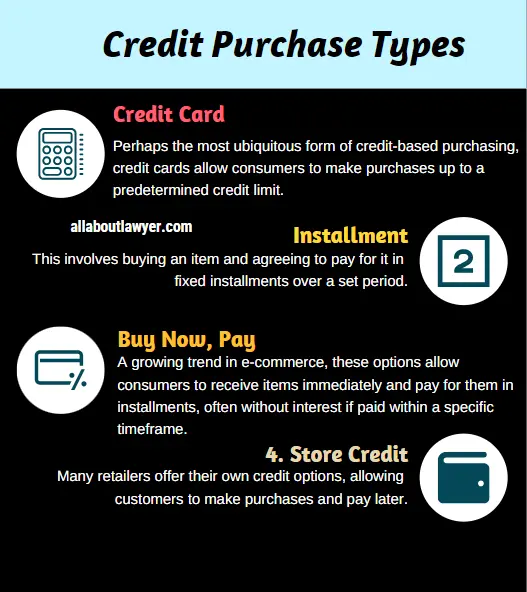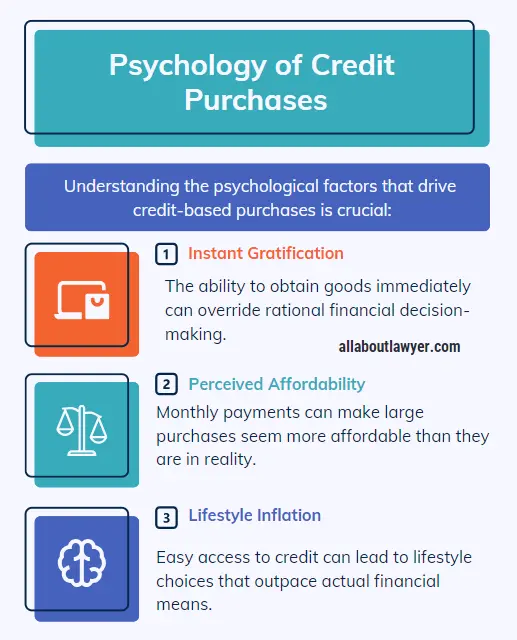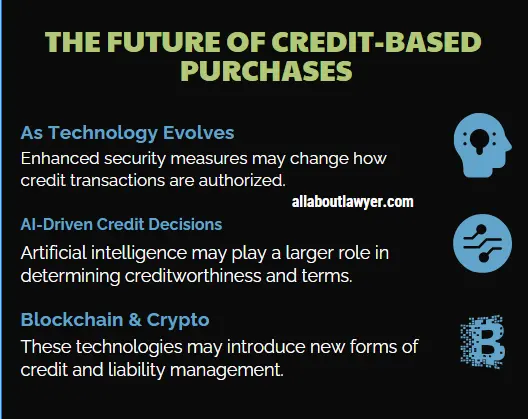Liability Created by Buying Products or Services on Credit
In today’s consumer-driven economy, the ability to purchase goods and services on credit has become an integral part of many people’s financial lives. While this practice offers convenience and immediate access to desired items, it also creates a significant financial liability that requires careful management. This comprehensive article will explore the various aspects of a liability created by buying products or services on credit and credit-based purchases, their implications, and strategies for managing the resulting financial obligations.
Table of Contents
Understanding Credit-Based Purchases
At its core, buying products or services on credit is a form of borrowing. When consumers opt for credit-based purchases, they enter into a financial arrangement where they receive goods or services immediately but agree to pay for them at a later date. This creates a credit obligation, which is essentially a promise to repay the borrowed amount according to agreed-upon terms.
Types of Credit-Based Purchases
There are several common forms of credit-based purchases:
1. Credit Card Transactions:
Perhaps the most ubiquitous form of credit-based purchasing, credit cards allow consumers to make purchases up to a predetermined credit limit.
2. Installment Purchasing:
This involves buying an item and agreeing to pay for it in fixed installments over a set period.
3. Buy Now, Pay Later Arrangements:
A growing trend in e-commerce, these options allow consumers to receive items immediately and pay for them in installments, often without interest if paid within a specific timeframe.
4. Store Credit:
Many retailers offer their own credit options, allowing customers to make purchases and pay later.

The Nature of the Financial Liability
When a consumer makes a credit-based purchase, they create a financial liability. This liability has several key characteristics:
1. Contractual Obligation: The debt is a legal commitment to repay the borrowed amount.
2. Interest-Bearing: Most credit arrangements involve interest charges, increasing the total amount owed over time.
3. Impact on Credit Score: How this liability is managed can significantly affect the consumer’s credit score and overall creditworthiness.
4. Potential for Accumulation: Without careful management, credit-based purchases can lead to significant debt accumulation.
Factors Influencing Credit-Based Liabilities
Several factors can influence the nature and extent of liabilities created by credit-based purchases:
1. Credit Terms: The specific terms of the credit agreement, including interest rates and repayment periods, greatly influence the overall liability.
2. Credit Limit: The maximum amount a consumer can borrow influences their potential for debt accumulation.
3. Payment Behavior: How consistently and promptly payments are made impacts both the liability and the consumer’s credit standing.
4. Interest Rates: Higher interest rates can significantly increase the total amount owed over time.
The Impact on Personal Finances
Credit-based purchases can have profound effects on an individual’s financial health:
1. Debt-to-Income Ratio: As credit liabilities increase, they can negatively impact a person’s debt-to-income ratio, affecting their ability to secure future credit.
2. Cash Flow Management: Regular payments towards credit liabilities can strain monthly budgets.
3. Credit Score Implications: Responsible management of credit obligations can improve credit scores, while mismanagement can severely damage them.
4. Long-Term Financial Planning: Significant credit liabilities can hinder long-term financial goals like saving for retirement or purchasing a home.
Related Articles For You:
What is the Difference Between Litigator and Lawyer?
Kansas City Product Liability Lawyer
Strategies for Managing Credit-Based Liabilities
Effective management of liabilities created by credit-based purchases is crucial. Here are some strategies:
1. Budgeting: Incorporate credit payments into a comprehensive budget to ensure timely repayment.
2. Prioritizing High-Interest Debt: Focus on paying off high-interest debts first to reduce overall interest costs.
3. Utilizing Balance Transfers: In some cases, transferring balances to lower-interest accounts can help manage debt more effectively.
4. Negotiating with Creditors: Some creditors may be willing to lower interest rates or adjust payment terms for consumers in good standing.
5. Avoiding New Credit: Limiting new credit-based purchases while paying down existing debt is often advisable.
The Psychology of Credit-Based Purchases
Understanding the psychological factors that drive credit-based purchases is crucial:
1. Instant Gratification: The ability to obtain goods immediately can override rational financial decision-making.
2. Perceived Affordability: Monthly payments can make large purchases seem more affordable than they are in reality.
3. Lifestyle Inflation: Easy access to credit can lead to lifestyle choices that outpace actual financial means.

Legal Aspects of Credit-Based Liabilities
Credit-based purchases are governed by various laws and regulations:
1. Truth in Lending Act: This federal law requires clear disclosure of credit terms to consumers.
2. Fair Credit Reporting Act: Governs how credit information is collected, shared, and used.
3. Credit CARD Act: Provides protections for credit card users, including restrictions on certain fees and practices.
The Role of Financial Education
Improving financial literacy is key to managing credit-based liabilities effectively:
1. Understanding Credit Terms: Consumers should fully comprehend the terms of credit agreements before entering into them.
2. Recognizing the True Cost of Credit: Understanding how interest and fees add to the cost of purchases is crucial.
3. Learning To budget Skills: Effective budgeting can help prevent over-reliance on credit.
Technological Tools for Managing Credit Liabilities
Various technological solutions can aid in managing credit-based liabilities:
1. Personal Finance Apps: These can help track spending, set budgets, and monitor credit usage.
2. Credit Monitoring Services: Provide alerts and insights into credit report changes and score fluctuations.
3. Automated Payment Systems: Can help ensure timely payments and avoid late fees.
The Future of Credit-Based Purchases
As technology evolves, so do the methods and implications of credit-based purchasing:
1. Biometric Authentication: Enhanced security measures may change how credit transactions are authorized.
2. AI-Driven Credit Decisions: Artificial intelligence may play a larger role in determining creditworthiness and terms.
3. Blockchain and Cryptocurrency: These technologies may introduce new forms of credit and liability management.

Conclusion
While credit-based purchases offer convenience and flexibility, they also create significant financial liabilities that require careful management. By understanding the nature of these liabilities, their impacts, and strategies for effective management, consumers can make more informed decisions about using credit for purchases. Ultimately, responsible use of credit can be a powerful financial tool, but it requires education, discipline, and ongoing attention to maintain a healthy financial balance.
FAQs
Q: How does buying on credit affect my credit score?
A: Buying on credit can modify your credit score in several ways. Responsible use, such as making timely payments and keeping your credit utilization low, can positively impact your score. However, late payments, high credit utilization, or defaulting on payments can significantly lower your score.
Q: Is it always bad to make purchases on credit?
A: Not necessarily. Using credit responsibly can help build a good credit history, which is beneficial for future financial opportunities. However, it’s important to only use credit for purchases you can afford to repay.
Q: How can I reduce my credit-based liabilities?
A: Strategies include creating a budget, prioritizing debt repayment, avoiding new credit purchases, considering balance transfers to lower-interest accounts, and potentially negotiating with creditors for better terms.
Q: What should I do if I can’t make my credit payments?
A: If you’re struggling to make payments, contact your creditors immediately. Many are willing to work out payment plans or hardship programs. You might also consider credit counseling or, in severe cases, debt consolidation or bankruptcy.
Q: How long does credit-based debt stay on my credit report?
A: Most negative information, including late payments and defaults, stays on your credit report for seven years. However, the impact on your credit score typically diminishes over time, especially if you demonstrate improved credit behavior.
About the Author

Sarah Klein, JD, is a former consumer rights attorney who spent years helping clients with issues like unfair billing, product disputes, and debt collection practices. At All About Lawyer, she simplifies consumer protection laws so readers can defend their rights and resolve problems with confidence.
Read more about Sarah
